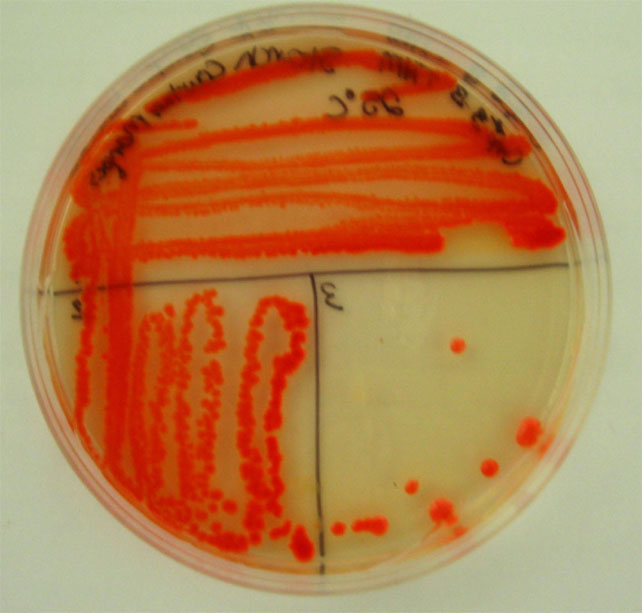Staphylococcus roseus: Difference between revisions
(New page: Classification Higher order taxa Bacteria; Firmicutes; Bacilli; Bacillales; Staphylococcaceae; Species Staphylococcus roseus Description and Significance Staphylococcus roseus is a l...) |
No edit summary |
||
| (17 intermediate revisions by 2 users not shown) | |||
| Line 1: | Line 1: | ||
{{Uncurated}} | |||
{{Biorealm Genus}} | |||
==Classification== | |||
===Higher order taxa=== | |||
Bacteria; Firmicutes; Bacilli; Bacillales; Staphylococcaceae; | |||
===Genus species=== | |||
<i>Staphylococcus roseus</i> | |||
===Description and significance=== | |||
''Staphylococcus roseus'' is a light red to red colored bacterium. | |||
[[http://microbewiki.kenyon.edu/index.php/Image:]] | |||
[[Image:Stroseus.jpg|frame|center| | |||
<i>Staphylococcus roseus</i> colonies on TSA exhibiting nondiffusable bright pink pigment.[[http://microbewiki.kenyon.edu/index.php/Image:]] | |||
<p>Plate provided by C. Marques and C. Dunlap and image taken by M. Glogowski</p>]] | |||
===Genome structure=== | |||
===Cell structure and metabolism=== | |||
<i>Staphylococcus roseus</i> is a non-motile gram positive cocci that is coagulase negative. The cocci are usually clustered in groups of 4. It gets its name “roseus” from the cultures pigment. Cultures exhibit circular colonies that are convex in shape, and smooth and dry texture. <i>S. roseus</i> is an obligate aerobe. <i>S. roseus</i> creates a alkaline rx in a glucose durham tube, but cannot utilize glucose, sucrose, nor lactose. Likewise, <i>S. roseus</i> is able to hydrolyze casein, triglycerides, and starch but not phospholipids. <i>S. roseus</i> also cannot utilize citrate as a carbon source. Also, <i>S. roseus</i> can be induced to create lysine decarboxylase. <i>S. roseus</i> does not have cytochrome c as an electron acceptor in its electron transport chain which reveals that it is a <i>Staphylococcus</i>, not a <i>Micrococcus</i>. <i>S. roseus</i> can break hydrogen peroxide into oxygen and water with catalase. The optimum temperature for growth is around 25°C. | |||
===Ecology=== | |||
===Pathology=== | |||
Current | ===Current research=== | ||
Currently, research is being done to better distinguish the differences between the genera <i>Micrococcus</i>, <i>Staphylococcus</i>, and <i>Sarcina</i>. Because the G+C ratio found in ''S. roseus'' is about 72-72.8%, which leads scientists to believe that these species are more closely related to the genus <i>Micrococcus</i>, instead of <i>Staphylococcus</i>. As of now the deciding factor of what characteristics belong to what group is determined by the utilization of oxidase, which is the test for the presence of cytochrome c. <i>Micrococcus</i> is oxidase positive, while <i>Staphylococcus</i> is oxidase negative. | |||
<i>Staphylococcus roseus</i> is sensitive to metronidazole. Metronidazole is a medical drug used to treat infections caused by microorganisms." | |||
===References=== | |||
Rosypalová1, Alena, J. Boháccaronek1, and S. Rosypal. "Deoxyribonucleic acid base composition of some micrococci and sarcinae". Antonie van Leeuwenhoek. 1966. Volume 32 Number 1/December. p. 192-96. | |||
Geary, Colin, and M. Stevens. "Rapid Lysostaphin Test to Differentiate Staphylococcus and Micrococcus species". Journal of Clinical Microbiology. 1986. Volume 23(6). p. 1044–1045. | |||
Hwang, Joseph, and Betzaida Maya. Microbiology Lab- Unknown: <i>Staphylococcus roseus</i>. Raw data. Loyola University Chicago, Chicago. 23 Apr. 2009. | |||
Jones, Dorothy, R. H. Diebel, and C. F. Niven Jr. "Identity of Staphylococcus epidermis". Journal of Bacteriology. 1963. Volume 85(1). p. 62-67. | |||
Cowan, S.T. (1974), “Cowan and Steel’s Manual for the identification of the medical bacteria.” Cambridge University Press. Cambridge p. 59. | |||
Created by students of [mailto:mglogow@luc.edu M Glogowski] | |||
Latest revision as of 20:06, 26 August 2010
A Microbial Biorealm page on the genus Staphylococcus roseus
Classification
Higher order taxa
Bacteria; Firmicutes; Bacilli; Bacillales; Staphylococcaceae;
Genus species
Staphylococcus roseus
Description and significance
Staphylococcus roseus is a light red to red colored bacterium. [[2]]

Plate provided by C. Marques and C. Dunlap and image taken by M. Glogowski
Genome structure
Cell structure and metabolism
Staphylococcus roseus is a non-motile gram positive cocci that is coagulase negative. The cocci are usually clustered in groups of 4. It gets its name “roseus” from the cultures pigment. Cultures exhibit circular colonies that are convex in shape, and smooth and dry texture. S. roseus is an obligate aerobe. S. roseus creates a alkaline rx in a glucose durham tube, but cannot utilize glucose, sucrose, nor lactose. Likewise, S. roseus is able to hydrolyze casein, triglycerides, and starch but not phospholipids. S. roseus also cannot utilize citrate as a carbon source. Also, S. roseus can be induced to create lysine decarboxylase. S. roseus does not have cytochrome c as an electron acceptor in its electron transport chain which reveals that it is a Staphylococcus, not a Micrococcus. S. roseus can break hydrogen peroxide into oxygen and water with catalase. The optimum temperature for growth is around 25°C.
Ecology
Pathology
Current research
Currently, research is being done to better distinguish the differences between the genera Micrococcus, Staphylococcus, and Sarcina. Because the G+C ratio found in S. roseus is about 72-72.8%, which leads scientists to believe that these species are more closely related to the genus Micrococcus, instead of Staphylococcus. As of now the deciding factor of what characteristics belong to what group is determined by the utilization of oxidase, which is the test for the presence of cytochrome c. Micrococcus is oxidase positive, while Staphylococcus is oxidase negative.
Staphylococcus roseus is sensitive to metronidazole. Metronidazole is a medical drug used to treat infections caused by microorganisms."
References
Rosypalová1, Alena, J. Boháccaronek1, and S. Rosypal. "Deoxyribonucleic acid base composition of some micrococci and sarcinae". Antonie van Leeuwenhoek. 1966. Volume 32 Number 1/December. p. 192-96.
Geary, Colin, and M. Stevens. "Rapid Lysostaphin Test to Differentiate Staphylococcus and Micrococcus species". Journal of Clinical Microbiology. 1986. Volume 23(6). p. 1044–1045.
Hwang, Joseph, and Betzaida Maya. Microbiology Lab- Unknown: Staphylococcus roseus. Raw data. Loyola University Chicago, Chicago. 23 Apr. 2009.
Jones, Dorothy, R. H. Diebel, and C. F. Niven Jr. "Identity of Staphylococcus epidermis". Journal of Bacteriology. 1963. Volume 85(1). p. 62-67.
Cowan, S.T. (1974), “Cowan and Steel’s Manual for the identification of the medical bacteria.” Cambridge University Press. Cambridge p. 59.
Created by students of M Glogowski
